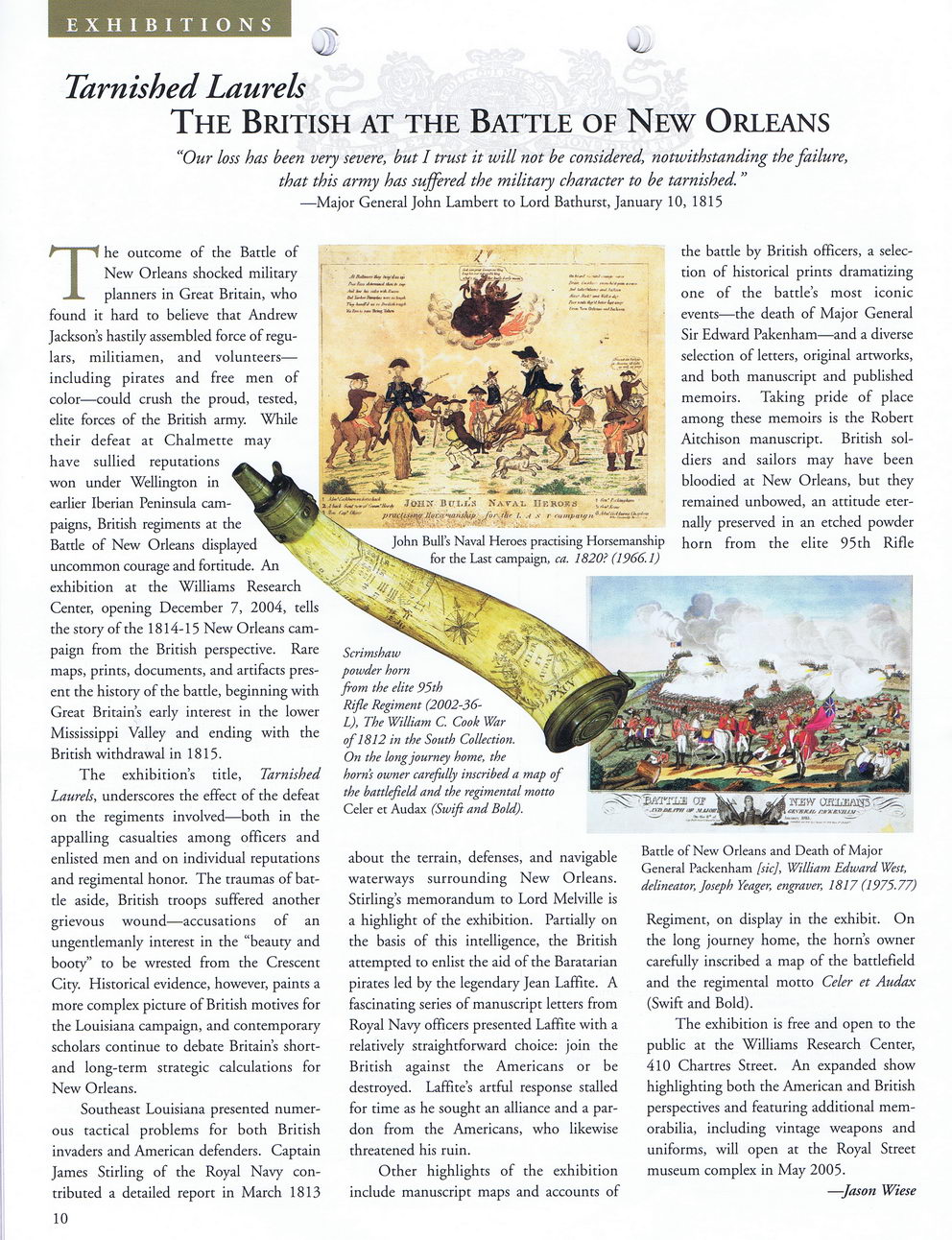This text was obtained via automated optical character recognition.
It has not been edited and may therefore contain several errors.
EXHIBITIONS ViJ? Tarnished Laurels The British at the Battle of New Orleans ?Our loss has been very severe, but I trust it will not be considered, notwithstanding the failure, that this army has suffered the military character to be tarnished. ? ?Major General John Lambert to Lord Bathurst, January 10, 1815 The outcome of the Battle of New Orleans shocked military planners in Great Britain, who found it hard to believe that Andrew Jackson?s hastily assembled force of regulars, militiamen, and volunteers? including pirates and free men of color?could crush the proud, tested, elite forces of the British army. While their defeat at Chalmette may have sullied reputations won under Wellington in earlier Iberian Peninsula campaigns, British regiments at the Batde of New Orleans displayed uncommon courage and fortitude. An exhibition at the Williams Research Center, opening December 7, 2004, tells the story of the 1814-15 New Orleans campaign from the British perspective. Rare maps, prints, documents, and artifacts present the history of the battle, beginning with Great Britain?s early interest in the lower Mississippi Valley and ending with the British withdrawal in 1815. The exhibition?s title, Tarnished Laurels, underscores the effect of the defeat on the regiments involved?both in the appalling casualties among officers and enlisted men and on individual reputations and regimental honor. The traumas of battle aside, British troops suffered another grievous wound?accusations of an ungentlemanly interest in the ?beauty and booty? to be wrested from the Crescent City. Historical evidence, however, paints a more complex picture of British motives for the Louisiana campaign, and contemporary scholars continue to debate Britain?s short-and long-term strategic calculations for New Orleans. Southeast Louisiana presented numerous tactical problems for both British invaders and American defenders. Captain James Stirling of the Royal Navy contributed a detailed report in March 1813 10 prai'tistity. Jlur.ixmanship. ^ Jb/\(hr r cumfmtt/n j|^John Bull?s Naval Heroes practising Horsemanship f?r the Last campaign, ca. 1820? (1966.1) r' -'>*2-* Scrimshaw ^ , jun ? , , C.-vVv: powaer horn *. from the elite 95th vCj: Rifle Regiment (2002-36- L), The William C. Cook War of 1812 in the South Collection. On the long journey home, the horn?s owner carefully inscribed a map of the battlefield and the regimental motto Celer et Audax (Swift and Bold). about the terrain, defenses, and navigable waterways surrounding New Orleans. Stirling?s memorandum to Lord Melville is a highlight of the exhibition. Partially on the basis of this intelligence, the British attempted to enlist the aid of the Baratarian pirates led by the legendary Jean Laffite. A fascinating series of manuscript letters from Royal Navy officers presented Laffite with a relatively straightforward choice: join the British against the Americans or be destroyed. Laffite?s artful response stalled for time as he sought an alliance and a pardon from the Americans, who likewise threatened his ruin. Other highlights of the exhibition include manuscript maps and accounts of the battle by British officers, a selection of historical prints dramatizing one of the battle?s most iconic events?the death of Major General Sir Edward Pakenham?and a diverse selection of letters, original artworks, and both manuscript and published memoirs. Taking pride of place among these memoirs is the Robert Aitchison manuscript. British soldiers and sailors may have been bloodied at New Orleans, but they remained unbowed, an attitude eternally preserved in an etched powder horn from the elite 95th Rifle Battle of New Orleans and Death of Major General Packenham [sic], William Edward West, delineator, Joseph Yeager, engraver, 1817 (1975.77) Regiment, on display in the exhibit. On the long journey home, the horn?s owner carefully inscribed a map of the battlefield and the regimental motto Celer et Audax (Swift and Bold). The exhibition is free and open to the public at the Williams Research Center, 410 Chartres Street. An expanded show highlighting both the American and British perspectives and featuring additional memorabilia, including vintage weapons and uniforms, will open at the Royal Street museum complex in May 2005. ?Jason Wiese

Battle of 1814 Orleans